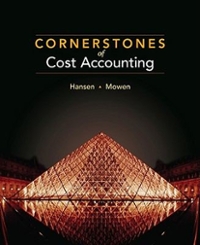"Well, we just need to figure out what activities are consuming the various types of overhead expenses. After I have that information, the rest of the process is long, but pretty straightforward." "Okay," Jeremiah nodded as he looked again at the list of costs and activities. "So, the biggest overhead expenses are the indirect salaries. I would think that 30% of those salaries are paid to the workers who help set up the production runs, 50% are paid to the experts in quality control, 15% are paid to the maintenance staff, and the remainder are paid to those who help with transporting materials and goods around the factory and receiving merchandise from vendors."how to lot salll wood ! Josey nodded. "That sounds about right; so that pool of overhead money needs to be split up between four activities. Let's call those activities "setups," "quality control," "maintenance," and "transportation/receiving." She continued examining the document. "The cleaning supplies and depreciation are both part of maintaining the equipment. Shipping costs are all part of transportation and receiving." "That sounds right," Jeremiah agreed. "Let's see. Well, most of the rent on the warehouse, probably 75%, is part of the transportation and receiving, wouldn't you say?" Josey nodded. "The rest is for holding merchandise waiting for quality control inspections." bob 'Right. And maintenance and setup of production runs each account for 45% of the utility costs. The remainder is pretty evenly split between transportation and quality control. The parts and repair costs are evenly split between maintenance and setups." he pondered a minute more. "Finally, the insurance costs are evenly distributed mong all four of these activities." Banw no surge of siteNotes about ABC The conference I attended gave a list of steps to follow to implement ABC: 1. Identify the cost objects 2. Identify the direct cost of the cost objects 3. Select allocation bases for assigning indirect costs to the cost objects 4. Identify the indirect costs 5. Compute an activity rate for each allocation base 6. Compute the amount of indirect costs assigned to each cost object 7. Determine total cost of the cost object by summing direct costs and assigned indirect costs I can't do all of that here, but I can start it and then Josey can have an accounting clerk finish the job. So, what are the cost objects? Well, the different types of candles, of course. The direct costs of the candles are the direct materials and the direct labor, and we do a pretty good job of tracking those, so I won't deal with them in these notes. What allocation bases should we use? Well, I can't figure that out until I know what the overhead is and how we can break it down. Let's see. We have two departments. Last year's data are as follows: Department Drivers Used Total Overhead Pouring 25,000 $400,000 (driver: DL hours) Finishing 125,000 $800,000 (driver: batches completed) We will need the overhead amount of $1,200,000 from this table broken down more into actual activities and categories. Digging through the accounting records from last year, I was able to categorize the overhead costs as follows: Actual OH Costs Indirect salaries $474,000 Cleaning supplies $24,000 Shipping costs $180,000 150 Rent on warehouse $72,000 Depreciation $360,000 Utilities $60,000 Parts and repairs $18,000 Insurance $12,000Driver Activity, Past and Present The following table presents the drivers used by the company last year: Overhead Activities Driver Budgeted Drivers Setups Setups 15,100 Quality Control Batches checked 2,500 Maintenance Machine hours 5,490 Shipping and Receiving Items transported 351,600 During the first quarter of this year, production dramatically increased in all three of the product lines. The following table shows the drivers used by the three specialty lines during that quarter: Products Batches Machine Items Batches (Outputs) Setups Checked Hours Transported Produced Sculpted 563 300 750 60,938 15,000 Imprinted 1,406 338 500 158,438 16,875 Additive 844 113 1,250 24,375 5 , 625a. Assume that Wedgewood spends $3.38 in DM and $0.63 in DL for each sculpted candle. What is the total cost to produce one sculpted candle under the ABC system? b. Now do the same calculation under the departmental MOH allocation method used in Chapter 3. c. Which estimate do you believe is the most accurate? Defend your answer.Assigning Costs to Activities in an ABC System Q-1. Using the information from Jeremiah's notes and his discussion with Josey, set up a table showing the percentage of each overhead cost account that should be allocated to each of the four activities. Use a total (also known as a proof) column to be sure you are allocating 100% of each cost. Create another table and determine the amount of overhead that should be allocated to each of the four ABC activities (setups, quality control, maintenance, and transportation/receiving). Again, use a total (or proof) column and a totals row to summarize your results. Attach a copy of both tables to this worksheet.-2. Using the information provided by Josey about estimated cost driver usage and your answer to Q-1, determine the activity rate for each activity in the new ABC system.Q-3. Using the information compiled by Jordan about the drivers used by each to each line. specialty candle line, determine the amount of overhead that will be allocated Q-4. Assuming that Wedgewood produced 180,000 sculpted candles; 202,500 imprinted candles; and 67,500 additive candles, how much MOH will be assigned to each candle under the ABC system













